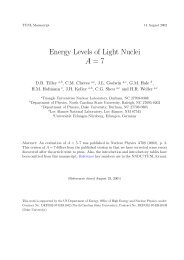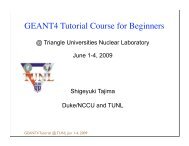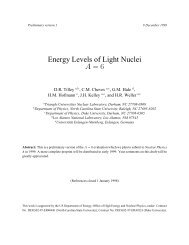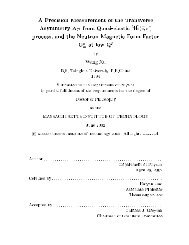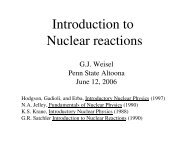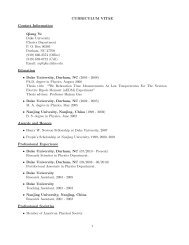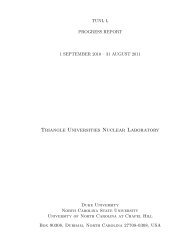Energy Levels of Light Nuclei A = 14 - Triangle Universities Nuclear ...
Energy Levels of Light Nuclei A = 14 - Triangle Universities Nuclear ...
Energy Levels of Light Nuclei A = 14 - Triangle Universities Nuclear ...
Create successful ePaper yourself
Turn your PDF publications into a flip-book with our unique Google optimized e-Paper software.
<strong>14</strong> O<br />
(Figs. 4 and 5)<br />
GENERAL (See also (86AJ01)).<br />
<strong>Nuclear</strong> models: (85BA75, 87BL15).<br />
Electromagnetic transitions: (89RA16, 89SP01).<br />
Astrophysical questions: (85TA1A, 87RA1D).<br />
Applied work: (89AR1J).<br />
Complex reactions involving <strong>14</strong> O: (87PE1C, 88ST1D, 89BA92, 89DR03, 89KI13).<br />
Reactions involving pions (See also reactions 5 and 7.): (86BA1C, 86BO1N, 86FO06, 86GE06,<br />
86SI11, 87BL15, 87KA39, 87KO1O, 87KO1Q, 87MI02, 87PA1H, 88AU1D, 88HA37, 88YU04,<br />
90HAZV).<br />
Hypernuclei: (89BA93).<br />
Other topics: (85AN28, 86AN07).<br />
Ground state <strong>of</strong> <strong>14</strong> O: (85AN28, 86HE26, 87SA15, 88WRZZ).<br />
For searches for 4 nand 4 H involving the production <strong>of</strong> <strong>14</strong> Osee(86BE35, 86BE54, 88BE02).<br />
1. <strong>14</strong> O(β + ) <strong>14</strong> N Q m =5.<strong>14</strong>31<br />
The best value <strong>of</strong> τ 1/2 =70.606 ± 0.018 s: see (78WI04). See also (76AJ04). <strong>14</strong> O decays<br />
predominantly to its analog state <strong>14</strong> N*(2.31) [J π ; T =0 + ; 1; E x = 2312.798 (11) keV, E γ =<br />
2312.593 (11) keV (82WA1D)]. The branching ratio to the state is (99.336 ± 0.010)%. This value is<br />
obtained by adopting (0.61 ± 0.01)% and (0.054 ± 0.002)% for the branching ratios to <strong>14</strong> N*(0, 3.95)<br />
[both 1 + ; 0 states]. Log f R t =3.4892 (2) for the 0 + → 0 + transition (81WH03), using the Wapstra<br />
masses for the atomic mass excess <strong>of</strong> <strong>14</strong> N, 1 H and n; E thresh· for the <strong>14</strong> N (p, n) threshold (81WH03)<br />
and E x shown above for <strong>14</strong> N*(2.31) (82WA1D). See (89OR01, 89OR09) for other calculations <strong>of</strong><br />
log ft [3.4884 (5)] and comments. Critical surveys <strong>of</strong> superallowed Fermi transitions lead to values<br />
for the first row <strong>of</strong> the Kobayashi-Maskawa matrix= 0.9970 ± 0.0021 (90HA13), 0.9989 ± 0.0012<br />
(90WI1J, 90WI10, 90WI05) [and D.H. Wilkinson, private communication].<br />
For the transitions to <strong>14</strong> N*(0, 3.95) log ft =7.266±0.009 (80WI13)and3.15±0.02, respectively.<br />
The Q-value difference between the 0 + −0 + transition in this decay and in the 26m Al decay has been<br />
measured by (87KO34). For a study <strong>of</strong> the longitudinal polarization <strong>of</strong> the positrons see (88GI02,<br />
89CA1J, 90CA1U). See also (89HA1X, 90HA1Q) and(86IS07, 86JA07, 86SI1H, 87JA07, 88LO01,<br />
89SA1P, 89WO1E; theor.).<br />
2. (a) 9 Be( 13 C, 8 He) <strong>14</strong> O Q m = −25.13<br />
(b) 9 Be( <strong>14</strong> C, 9 He) <strong>14</strong> O Q m = −34.44<br />
68



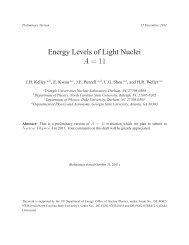

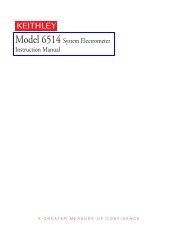
![TUNLXXXIV.tex typeset [1] - Triangle Universities Nuclear Laboratory](https://img.yumpu.com/47618358/1/190x245/tunlxxxivtex-typeset-1-triangle-universities-nuclear-laboratory.jpg?quality=85)
